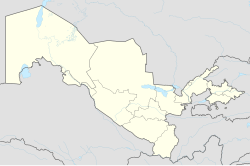Quva
| Quva | ||
| Basic data | ||
|---|---|---|
| State : |
|
|
| Province: | Fargʻona | |
| District: | Quva | |
| Coordinates : | 40 ° 31 ' N , 72 ° 4' E | |
|
|
||
| Residents : | 36,975 (2012) | |
Quva , also Kuwa (Uzbek Cyrillic Қува), is a town in the Fargʻona province in the Ferghana Valley in eastern Uzbekistan . The city has a population of around 37,000 (2012 estimate). It does not belong to any of the districts ( Rajons ) of the province, but is directly subordinate to the province (comparable to an independent city in Germany). It is also the capital of the Quva district .
location
The city is located about 30 km northeast of the provincial capital Fargʻona in the far east of the Fargʻona province. The nearest major cities are Shahrixon in the north and Asaka in the northeast, both around 40 kilometers away and located in Andijon Province . The Marg'ilon - Andijon railway runs through the north of the urban area with its own train station for Quva.
The terrain is flat and lies north of a range of hills. At the foot of the range of hills, the Southern Ferghana Canal runs south of the city. In the chain of hills south of Quva lies the Karkidon reservoir , the drainage of which is partly directed into the southern Ferghana Canal and partly used to irrigate the agricultural areas surrounding the city.
history
The area of Quva was first settled in the 4th – 3rd centuries. Century BC. In the Middle Ages there was an important city here. In Arabic sources from the 8th to 10th centuries the name of the city is passed down as "Kubo" or "Kuba". The structure of the city is also handed down from writings from the 10th century: It had a core surrounded by a city wall with towers and gates, the Schahrestan , in which a specially walled citadel was still located. Outside the city walls were trading and craft settlements called Rabat (suburb).
The city was on the old caravan route to Kashgar , which was part of the Silk Road . After Ahsiket , the medieval Kubo was the second most important city in the Ferghana Valley. In addition to trade, handicrafts were highly developed, including pottery, glass production, metal processing and goldsmithing. In the 13th century the city was destroyed by the Mongol invasion .
In 1927 today's Siwdlung was founded under the name Fedchenko ( Федченко ). After building a furniture factory and a canning factory, the population of the settlement increased. In 1974 it was promoted to city.
archeology
The first excavations took place in 1940/41 while the work on the southern Ferghana Canal was being carried out, others followed in 1951. However, the excavations from 1956–1958 only yielded greater results. A residential area from the 7th century was excavated north of Shahrestan and the remains of a Buddhist temple from the 7th to 8th centuries were discovered. The remains of a colossal statue , figures of various deities and broken clay Buddha images were found in the temple . The temple was destroyed during the Arab conquest of Central Asia.
Part of the walls of Shahrestan was reconstructed in the south of the excavation site. In front of it a 350 meter long and 20 meter wide green area with a fountain was created. Two flights of stairs lead to a pavilion built in 1998 on Shahrestan with a larger than life statue of the early medieval astronomer Farghani , who, according to the results of studies by archaeologist Gennadiy Ivanov, came from Quva.
description
According to the 1989 population census, the city had 26,062 inhabitants, according to a calculation for 2012, the population was 36,975.
The main industries in the city are furniture manufacturing and the textile industry.
sons and daughters of the town
- Abu l-Abbas Ahmad ibn Muhammad ibn Kathir al-Farghani († after 861), astronomer
literature
- Article Кува in the Great Soviet Encyclopedia (BSE) , 3rd edition 1969–1978 (Russian)
Web links
- Kuva on asiatravel-discoveries.com
- Kuva, Fergana Valley at www.advantour.com
Individual evidence
- ↑ Quva (Uzbekistan) - Fergana (Uzbekistan). In: Distance Calculator. Retrieved November 11, 2016 .
- ^ The ancient Settlement of Kuva. In: www.orexca.com. Retrieved November 10, 2016 .
- ↑ Kuva . In: Great Soviet Encyclopedia . a translation of the third edition. tape 3 . Macmillan Inc. New York, Collier Macmillan Publishers London, 1974-1983 (online at thefreedictionary.com ).
- ^ Kuva, Fergana Valley. In: www.advantour.com. Retrieved November 11, 2016 .
- ↑ Всесоюзная перепись населения 1989 г. (1989 census). In: Демоскоп Weekly. Retrieved November 7, 2016 (Russian).
